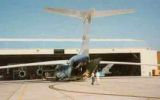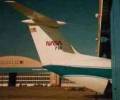The mission took place in September 1993 on the Kuiper Airborne Observatory, NASA Ames, California, USA. We did astronomical observation flights with the KAO for studying fine-structure emission lines at 205 µm of N+ in the objects DR21, S106, W49. I was in control of the acousto-optical spectrometer and the data retrieval and preprocessing during the flight. Core of the heterodyne receiver is the Schottky mixer block. The whisker wire of 25 µm diameter is sharpened to a tip and then contacted mechanically to a diode on the chip with contact areas as small as 250 nm diameter.
From left to right:
|







